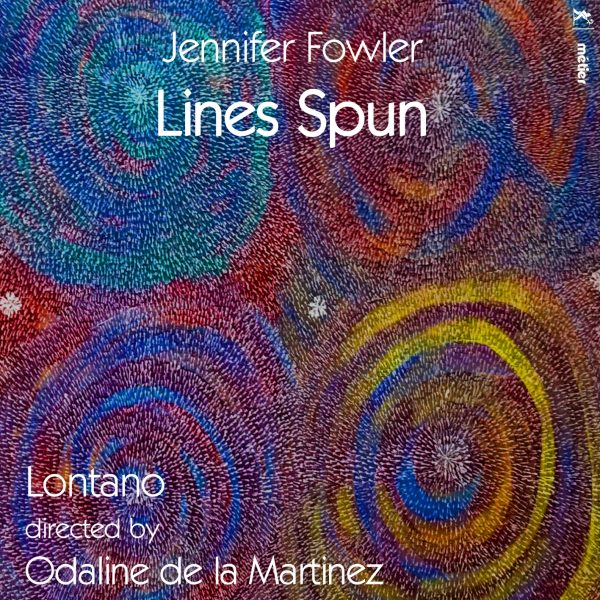Fanfare
Before music means anything, even before there is a style of music, there is the most basic fact, that music is a code. In this collection entitled Lines Spun, the Australian composer Jennifer Fowler exploits this code quite frequently in a bare, pared-down way. She is so rigorous that there are monophonic passages, meaning that they proceed one note at a time, without chords and harmony, or sometimes the merest suggestion of those elements. I wasn’t reminded of Minimalism so much as the paintings of Barnett Newman, where a single line is sometimes the only intrusion into a plain field of red or white.
Born in 1939, Fowler is described as a “free-lance composer” in the booklet; she is certainly an independent one. Based in London, she works in every genre. Here we get six chamber works, of which three are vocal. The most striking success, to my mind, is Letter from Haworth for mezzo-soprano accompanied by clarinet, cello, and piano. The letter in question was written in an anguished mood by Charlotte Bronte in 1845 to a foreign-language teacher she had studied with in Brussels. After returning home to Yorkshire she began a correspondence, which the teacher kept up in a friendly way until he became uncomfortable with the intensity of Charlotte’s feelings for him.
When his replies stopped coming, she asked a friend visiting the continent to deliver a letter from her and to bring back by hand the teacher’s reply. But there was none, and she sat down in a fit of lovelorn pain, dashing off a cry from the heart, which Fowler has set in full. The singer begins by briefly narrating the letter and then singing it, while the accompaniment is fuller and more harmonized than is typical here. Mezzo Lauren Easton has clear enunciation and imbues Charlotte’s words with convincing emotion. Perhaps it’s me, but hearing how beautifully Fowler sets the text felt more satisfying than her sparer modes.
In many ways she is a conceptual artist. Quite often, as in Line Spun with Stars for flute, cello, and piano, or Lament, an elegy on the death of a friend scored for oboe, clarinet, and bassoon, Fowler severely restricts the notes available to her. The expansion and contraction of these notes forms the gradually evolving structure of the piece. In Line Spun with Stars the word “line” refers to the sequencing of single notes, usually delivered by one instrument at a time, while the gravitational attraction that brings the line back to a note creates a “star.”
Newman was an Abstract Expressionist, where the essence of a painting is to express a feeling without actually denoting the feeling or creating a realistic figure around it. Likewise, Fowler, even when she is lamenting the death of a friend, doesn’t resort to the figurations I associate with grief, a funeral, or even sadness. The oboe, clarinet, and bassoon, proceeding inside the confines of restricted notes, spin out lines of abstract music that we the listener must decode. That isn’t to say that Fowler isn’t expressing her sorrow, but that she does it in a personally coded way, at least as I hear it.
Some may find the task too thankless to pursue, and I must admit that the six works here tend to merge into one another, being based so rigorously on thought-out principles. But Fowler belongs to a genuine strain of modern art, and when she writes her own text, as in From the Cave Mouth for soprano, clarinet, and violin (the cave could contain an oracle or stand for the source of artistic inspiration), the words are used in fragmentary, gnomic expression, forming patterns that suggest meaning while standing on the frontier of meaning like concrete poetry. Postmodern art embraces such codes in every medium, and if you are attuned to it, Fowler’s music represents a sophisticated example of what can be done with the code of music. All the performers from the ensemble Lontano are expert, as are both singers.
@divineartrecordingsgroup
A First Inversion Company
Registered Office:
176-178 Pontefract Road, Cudworth, Barnsley S72 8BE
+44 1226 596703
Fort Worth, TX 76110
+1.682.233.4978












![Listen to the full suite of Marcel Dupré’s Variations Sur un Noël, Op. 20 from Alexander Ffinch’s #Expectations release today! listn.fm/expectations [in bio]](https://scontent-dfw5-1.cdninstagram.com/v/t51.71878-15/588904367_2327488161082898_8709236950834211856_n.jpg?stp=dst-jpg_e35_tt6&_nc_cat=105&ccb=7-5&_nc_sid=18de74&efg=eyJlZmdfdGFnIjoiQ0xJUFMuYmVzdF9pbWFnZV91cmxnZW4uQzMifQ%3D%3D&_nc_ohc=BGoHgV_YYfIQ7kNvwFvvXba&_nc_oc=AdnY7hccfKOvRR9BWymblLySWNaIoBkgmaPGjAyJRFM2l6PDGIgY1d-gznrnsT06ogk&_nc_zt=23&_nc_ht=scontent-dfw5-1.cdninstagram.com&edm=ANo9K5cEAAAA&_nc_gid=nQgk-Tk5yrgPtqNl_l40Kg&oh=00_AfqTWhcA-oB0Vsz-nTtTIIoSuTQy3L_q1aDonMFOl6YgCQ&oe=695E332A)